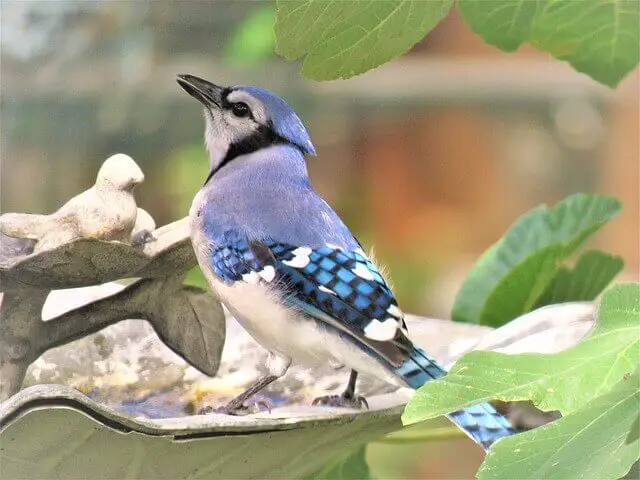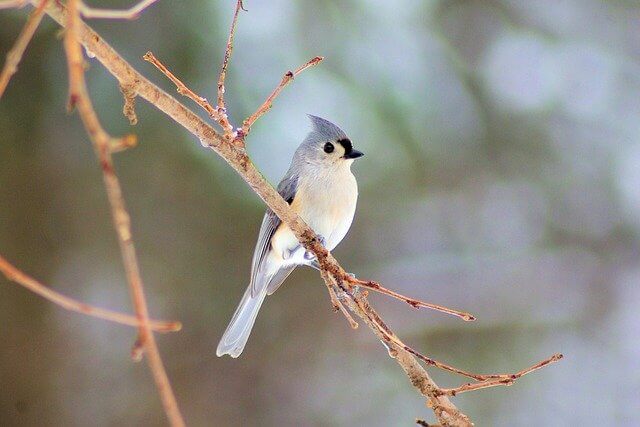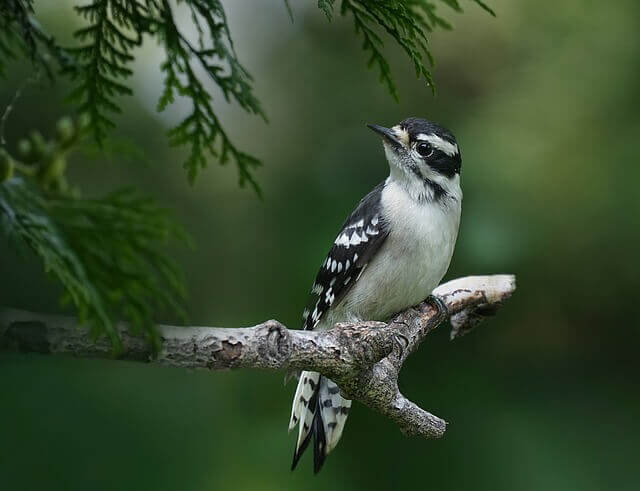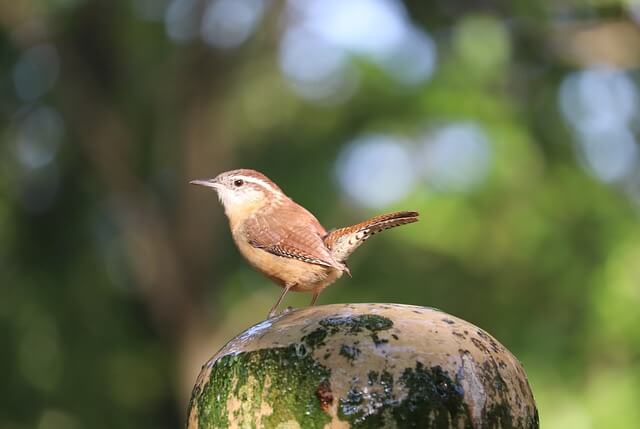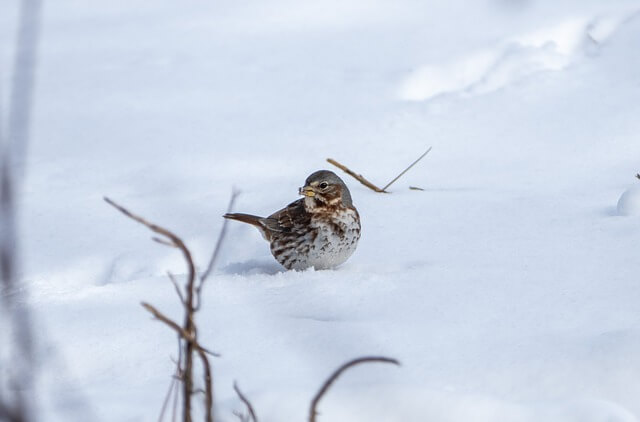Embark on an enthralling journey through Missouri’s diverse birding landscape with our comprehensive guide. This Ultimate Guide showcases the 62 most common birds found throughout the Show-Me State, offering detailed insights into their habitats, behaviors, and distinctive characteristics.
Whether you’re a dedicated birder, an outdoor enthusiast, or simply curious about Missouri’s unique birdlife, this guide provides a captivating exploration of the avian wonders that grace this scenic state.
Table of Contents [show]
Most Common Birds in Missouri
Northern Cardinal
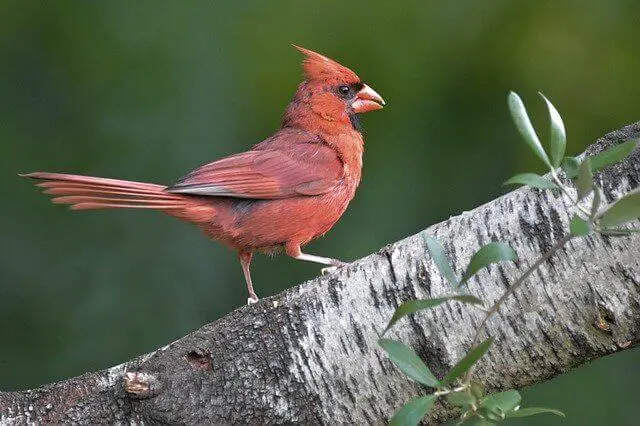
The Northern Cardinal, or simply the cardinal, is a songbird that lives in North America. It ranges from southern Canada to northern Mexico and parts of Central America. They are common in all types of habitats including woods, thickets, forests and farmlands.
Cardinals have a diet consisting mainly of seeds such as sunflower seed kernels and berries, but also eat some insects such as caterpillars and spiders. They migrate to the southern United States for the winter because it has warmer weather with more food sources.
- Frequency: 63.80%
- Color: Mostly red with a black mask on the face, short pink bill
- Habitat: woodlands, gardens, parks, backyards, and wetlands
- Range: USA, Canada, Mexico
- Size: 8.2 – 9.3″ inches
- Weight: 33 – 65 grams
- Diet: Fruits, berries, and insects (grasshoppers, beetles, snails, cicadas)
- Family: Cardinalidae
- Genus: Cardinalis
Blue Jay
The Blue Jay is a North American bird that has an estimated population of 14 million. They are most commonly found in the Eastern part of Canada and the United States, but they can also be found as far west as California. The blue jay’s range is so wide because it has adapted to various climates such as humid subtropical forests, semi-arid deserts, temperate deciduous forests and alpine meadows.
Their diet consists of berries, nuts, insects and occasionally small animals such as mice or other birds. These food sources make up about 90% of their diet, but some populations will take advantage of crops.
- Frequency: 47.79% (Year-round)
- Color: Blue crest on the head, wings, back, and tail, and has a white face and belly
- Habitat: Deciduous and mixed forests, mixed woodlands, backyards, parks
- Range: Southern Canada, Eastern and Central United States, Florida and Texas
- Size: 8 – 12″ inches
- Weight: 70 – 100 grams
- Diet: Nuts, seeds, caterpillars, grasshoppers, and beetles
- Family: Corvidae
- Genus: Cyanocitta
American Robin
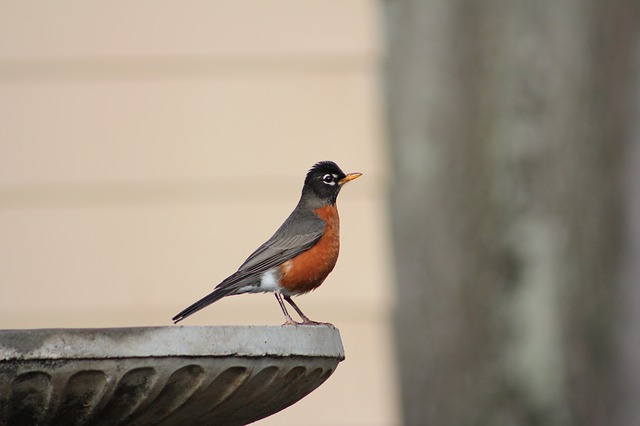
The American robin is a medium-sized bird with an average length of 12 inches and weight of 3 ounces. The American robin can be found in all 50 states and in every Canadian province. Their range extends from the Atlantic coast to the Pacific coast, south to Central America, Mexico, northern South America, Greenland, Iceland and Europe as far north as Scandinavia. American Robins eat invertebrates such as worms or beetles; they also consume berries and fruits when available.
The robins are mostly migratory birds, which means they spend winter months in warm climates as far south as Argentina or Venezuela. They then return to their breeding grounds around March or April when things start to get warmer again back north, where they will raise their young.
- Frequency: 44.42%
- Color: Mostly brown on the back with an orange colored breast
- Habitat: Wooded areas, backyards, parks, fields
- Range: USA, Canada, Mexico
- Size: 12 – 16″ inches
- Weight: 72 – 95 grams
- Diet: Fruits, berries and insects (earthworms, beetles, caterpillars)
- Family: Turdidae
- Genus: Turdus
Mourning Dove
The Mourning Dove is a type of bird that inhabits North America. The Mourning Doves range extends from the southern border of Canada to Central America, with populations found in almost every state in the US and three Canadian provinces.
Mourning Doves live near wetlands, forests, fields and meadows; this helps them find food such as seeds, nuts and berries. They are omnivores, so they will eat anything that is available for their consumption! They migrate for part of the year between Texas in the winter and the central and eastern states in the summer.
- Frequency: 43.58%
- Color: Light gray-brown and lighter and pinkish below. The wings have black spots.
- Habitat: Open habitats, urban areas, farms, prairie, grassland, wooded area
- Range: USA, Canada, Mexico, Central America, Greater Antilles
- Size: 12″ inches length
- Weight: 112 – 170 grams
- Diet: Rapeseed, corn, millet, safflower, sunflower seeds, pokeberry, sesame, and wheat.
- Family: Columbidae
- Genus: Zenaida
Red-bellied Woodpecker
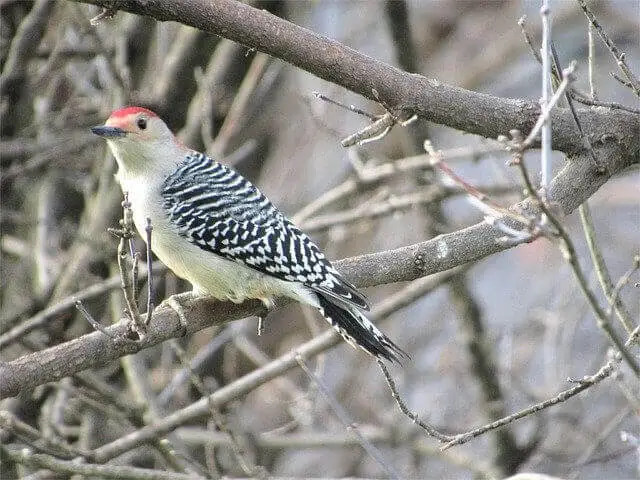
The Red-bellied Woodpecker, is a medium-sized woodpecker of the genus Melanerpes from the family Picidae. It breeds mostly in the eastern United States, primarily ranging east of the Mississippi and moving southward to Canada and southern Texas. They are very agile and have strong wings that are nearly as long as its body.
Hatching in the spring and late summer (birds usually lay eggs in May and June), the red-bellied woodpecker generally returns to its old nesting grounds throughout the year, except for a brief period in the fall. Nesting takes place in protected, sheltered areas such as hollow logs, brush, trees, grasslands, and fields.
- Frequency: 42.75%
- Color: Gray on body and face and underparts. Black and white pattern on wings, back, and tail.
- Habitat: Forests, backyards
- Range: Southern Canada, Eastern United States, Florida
- Size: 9 – 10.6″ inches long
- Weight: 56 -91 grams
- Diet: Insects, tree frogs, eggs of small birds, oozing sap, and small fish.
- Family: Picidae
- Genus: Melanerpes
Tufted Titmouse
The Tufted Titmouse is a small bird that lives in North America. They live in deciduous forests and range from the Eastern United States to the Western US, with their range extending north to Canada and south into Mexico. They are mostly found in deciduous forests with an understory of shrubs or vines; they prefer to nest close to the ground where leaves provide cover.
They are omnivores which means they eat both plants and animals but mostly insects, spiders, fruits, seeds and nuts as well as berries. Titmice migrate south for winter and then return north during springtime to breed.
- Frequency: 40.97%
- Color: Gray upperparts, white front, a tufted gray crest on the head
- Habitat: Deciduous forests, river basin, backyards, swamps
- Range: Canada, USA, and Mexico
- Size: 5.5 – 6.4″ inches
- Weight: 18 – 26 grams
- Diet: Nuts, insects, berries, seeds small fruit, and snails
- Family: Paridae
- Genus: Baeolophus
Downy Woodpecker
The Downy Woodpecker is the smallest woodpecker in North America. These beautiful birds prefer open deciduous woods and brushlands. This includes mixed-grass prairie, mixed-pace and deciduous forests. They are particularly less frequent in conifer-dominant forests unless a cavity-type understorey exists.
Because of the smaller size of the Downy, they are often overlooked when searching for birds during the spring and summer when these birds are most active. Downy woodpecker nests near trees in both natural and artificial cavities and roosts. A Downy will nest anywhere where there are trees so they can keep returning to their favorite spots for food.
- Frequency: 39.13%
- Color: Black with a white throat, belly, and back. White spots on wings
- Habitat: Deciduous forests and thickets, roadside, grasslands, backyards, parks
- Range: Canada, USA, and Mexico
- Size: 5.5 – 7.1″ inches in length
- Weight: 20 – 33 grams
- Diet: Mostly insects and beetles and ants, also gall wasps, caterpillars
- Family: Picadae
- Genus: Dryobates
American Goldfinch

The American Goldfinch is a shy bird from the Finch family, that is common around urban areas and deciduous forests. The American goldfinch likes to roost together in large coniferous trees, near tall walls, or along river banks. Because the American Goldfinch likes to feed on seeds, it is beneficial to have hanging feeders or food foragers placed near the birdhouse or nest.
When using seeders or foragers, do not stack them too high, as these birds tend to perch when watching from a perch. Providing a variety of suet, such as nuts, grapes, berries, and millet, will keep the birds from getting bored with their usual food.
- Frequency: 38.48%
- Color: Face, neck, and underside are yellow, black wings with white bars
- Habitat: Deciduous forests and thickets, roadside, grasslands, backyards, meadows
- Range: Canada, USA and Mexico
- Size: 4.3 – 5.5″ inches length
- Weight: 12 -18 grams
- Diet: Grass, dandelions, chickweed, sunflowers and ragweed, thistle, red alder, birch, spruce seeds
- Family: Carduelinae
- Genus: Spinus
American Crow

American Crow is a very common black bird found in North America. Crows favor open, grassy areas with large trees close by. Forest and agricultural areas are the perfect habitat for the common ravens foraging for their food. American crows will even use nearby woodlands and brushland edges for roosting and breeding.
In the fall and winter, American Crows make their nests near water or near areas with cover where they can hide during harsh weather. They build elaborate nest sites such as burrows, brush piles, and hollow trees. They also take advantage of any standing water or body of water they can find around their area.
- Frequency: 35.02%
- Color: Black
- Habitat: Open country, farms, parks, woodlands, towns, cities
- Range: Canada, USA, Mexico
- Size: 16 – 21″ inches
- Weight: 315 -620 grams
- Diet: invertebrates, carrion, seeds, eggs fish, grains, mice, frogs, and other small animals.
- Family: Corvidae
- Genus: Corvis
Carolina Wren
Carolina Wrens are small, cavity nesters that feed on small insects. Their name comes from the state of North Carolina where they live. They prefer to feed on moths, berries and beetles.Carolina Wrens often feeds on lizards, snakes, or frogs. They also eat a small portion of vegetation, like seeds from sweetgum, bayberry, or poison ivy, which is what makes them a winter visitor.
In the spring time, the male Carolina wrens leave the area in search of females for mating. If possible, the birds must be near a shoreline because this is where the female birds will lay their eggs. As the weather warms, the birds’ tastes change and they seek out food in different ways, depending on the season.
- Frequency: 34.84%
- Color: Black cap and throat with white cheeks. Light gray wings, back, and tail.
- Habitat: Deciduous forests, suburbs, parks, backyards
- Range: USA ( Texas, Florida, New Jersey, and Kansas)
- Size: 4.5 – 5.1″ inches long
- Weight: 9 – 12 grams
- Diet: Insects, berries, seeds
- Family: Paridae
- Genus: Poecile
European Starling
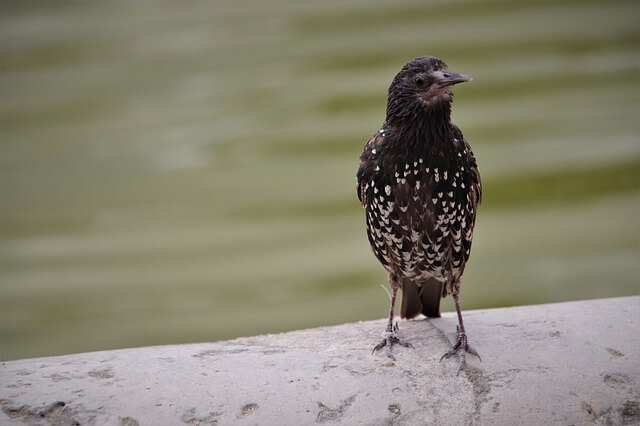
The European Starling is a medium-sized passerine bird from the starling family of Sturnidae. These birds are capable of foraging in sub-freezing weather, on roadsides, in fields, and in parks. The majority of the European starlings live in Britain and Ireland, although there is an increase in sightings reported from other areas of Europe, particularly France and Germany. They are also very common from southern Canada, the United States, and Alaska.
The starlings are omnivorous birds, eating seeds, grasses, fruits, and nectar from trees. They also eat, insects, snails, millipedes, and carrion. Their diet is largely carnivorous, with larger numbers of berries and suet being eaten by them than any other wild bird.
- Frequency: 32.89%
- Color: Black with glossy iridescence plumage.
- Habitat: Forests, woodlands, backyards, edges, yards, and parks.
- Range: North America, Europe, Africa, India, Middle East, China.
- Size: 7 – 9″ inches long
- Weight: 60 – 100 grams
- Diet: Insects (ants, beetles, invertebrates), fruits, seeds, berries
- Family: Sturnidae
- Genus: Sturnus
White-breasted Nuthatch
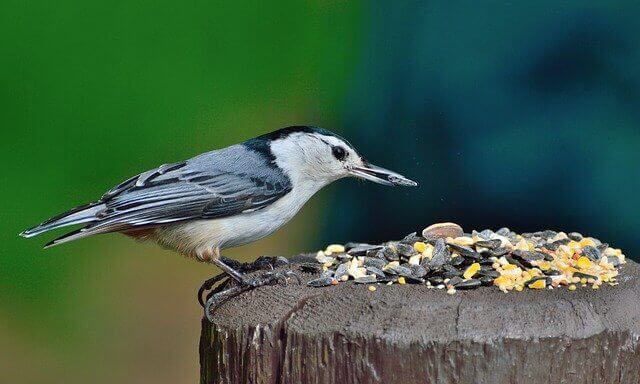
The White-breasted Nuthatches range from the east coast of North America to the Rocky Mountains. The majority of their population is found in Canada and in the Western United States. The habitat of this bird is mostly forests, but they are also found in parks and gardens too. They feed on seeds, nuts, insects like ants, beetles, grasshoppers and spiders.
White-breasted nuthatches eat these insects while perched on a tree branch or by sitting on a tree trunk while looking for food. This small bird is a frequent visitor to backyard bird feeders and garden birdhouses. Like many other species, the white-breasted nuthatch is an opportunist, taking advantage of a bird’s desperation for food.
- Frequency: 27.92%
- Color: Has a white face, flanks, and chest. It has a black cap on its head a bluish-gray upper and a brown belly
- Habitat: Deciduous forests, conifers, roadside, rivers, backyards, parks
- Range: Southern Canada, USA
- Size: 5.9″ inches
- Weight: 20 grams
- Diet: Acorn nuts, hickory nuts, ants, caterpillars, scale insects, pine weevils
- Family: Sittidae
- Genus: Sitta
Dark-eyed Junco
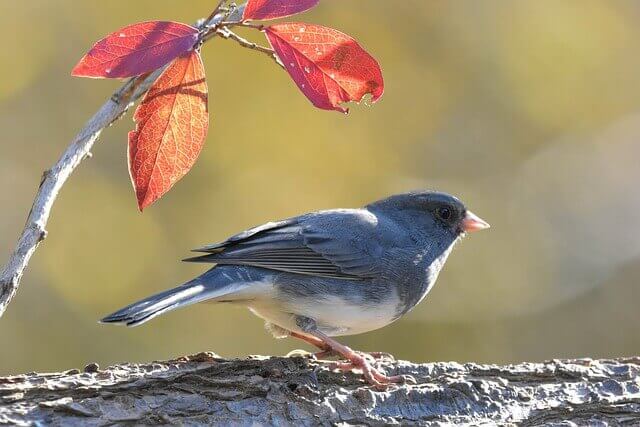
The Dark-eyed Junco is a small songbird that lives in North America. They range from Alaska to the southern United States and Mexico, with most of their population living near water. They have been found on all continents except Antarctica.
Dark-eyed juncos typically live near waterways, marshes, wetlands and lakesides; however, they can also be found in dryer areas such as deserts or forests with brushy undergrowth. The diet of these birds consists mainly of seeds that they find on the ground or low vegetation, but will occasionally eat berries and insects.
- Frequency: 27.59%
- Color: Gray head, neck, breast, gray/brown backs and wings, white underside
- Habitat: Wooded areas, forest edges, roadsides, gardens, parks.
- Range: USA and Canada
- Size: 5.1 – 6.9″ inches
- Weight: 18 – 30 grams
- Diet: Seeds, insects, and arthropods
- Family: Passeriformes
- Genus: Junco
Eastern Bluebird
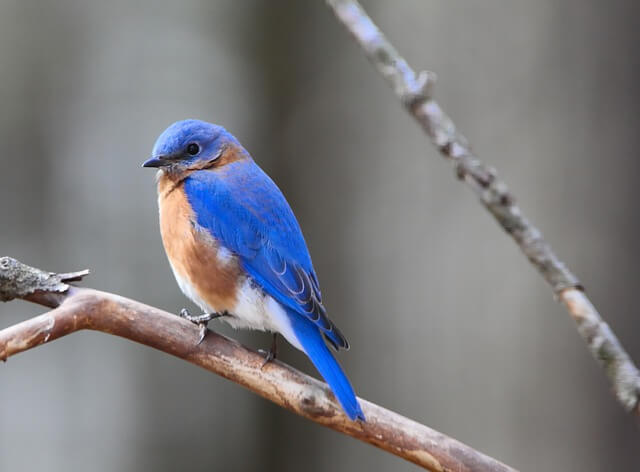
The Eastern Bluebird is an uncommon, but lovely little North American bird found mostly in deciduous woods, farm fields, and open wooded areas. These beautiful birds have gray bluish wings vivid, with a deep blue above and rusty red color on the breast and throat. This species is only found in the Northeastern United States, though breeding populations exist in southern Canada and Mexico.
The diet of the eastern bluebird consists mainly of winter berries, but they also eat other types of insects, including aphids, ladybugs, lacewings, mites, spiders, grasshoppers, ticks, mice, birds, frogs, salamanders, crickets, roaches, earthworms, flies, and mosquitoes.
- Frequency: 25.78%
- Color: Has a blue head, back, and wings. reddish-brown breast
- Habitat: Open woodlands, farmlands, and orchards.
- Range: Southern Canada to the Gulf states, East of the Rockies and south to Arizona to Nicaragua
- Size: 5.5 – 7.1″ inches in length
- Weight: 20 – 33 grams
- Diet: insects and other invertebrates
- Family: Turdidae
- Genus: Sialia
Red-winged Blackbird
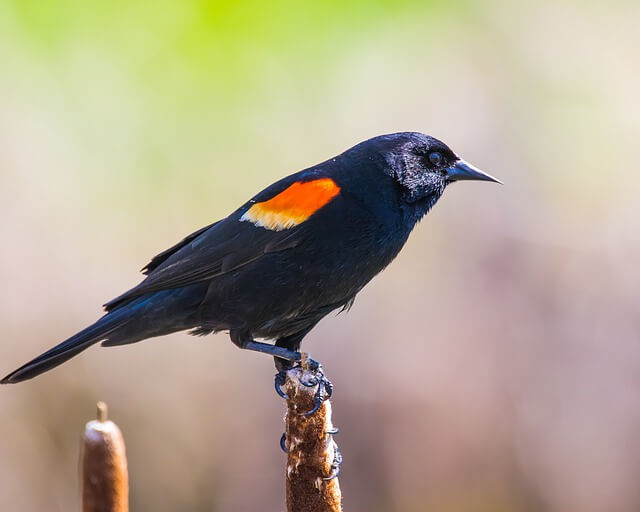
The beautiful and colorful red-winged blackbird has made its mark on popular culture and continues to attract scores of bird watchers every year. The species is known for its distinct, bright red and yellow coloring, along with its prominent tail feathers. Red-winged blackbirds are among the most popular and easiest species to identify, making it a favorite companion bird with bird watchers everywhere.
This species has been widely distributed in North America since at least 1989, when it was first discovered in central California. However, the most recent records indicate a wide dispersal throughout the continent, with birds being recorded from Florida and western Canada, as well as northern Mexico, and southwestern United States.
- Frequency: 25.45%
- Color: All black with red patches on shoulder and a yellow wing bar
- Habitat: Deciduous forests, conifers, roadside, rivers, backyards, parks
- Range: North America, Central America
- Size: 6.7 – 7.1″ inches length
- Weight: 41.5 – 65 grams
- Diet: Seeds and insects (butterflies, dragonflies, moths, frogs, worms, spider, snails, carrion, flies.)
- Family: Icteridae
- Genus: Agelaius
White-throated Sparrow
With its stout, stocky body size and long thin legs, it is easy to see why the white-throated sparrows are so common on the ground and in coniferous forests of central and eastern North America. They live both in open and wooded areas, in fields, swamps, marshes, along the rivers and streams, and along roads and railways.
They are often found in fields near roadways, because they eat small plant parts. Their preferred food is the coniferous woods and low growing shrubs; other favorites are grasses, weeds, and grass roots.
- Frequency: 24.34%
- Color: Brown and gray head pattern. Black-and-white-striped head, white throat, and yellow near the eye.
- Habitat: Deciduous forests and thickets, roadside, grasslands, backyards
- Range: Eastern North America, Atlantic Canada
- Size: 5.9″ – 7.5″ inches long
- Weight: 22 – 32 grams
- Diet: Seeds, insects, and berries
- Family: Passerellidae
- Genus: Zonotrichia
House Sparrow

The House Sparrow is found in all parts of the world, but their range is limited to areas with a temperate climate. They live throughout North America and Europe, and they migrate seasonally from northern to southern regions. The habitats where these birds can be found include open fields, grasslands, farmland, parks and gardens.
In addition to seeds such as wheat and corn that have been dropped by humans or other animals during harvesting, these birds will also eat insects on occasion. They breed in all seasons, but are best seen in the late spring or early summer.
- Frequency: 24.29%
- Color: Gray head marking, a reddish-brown back, and gray underparts
- Habitat: Urban centers, suburban areas, backyards, edges, yards, and parks
- Range: North America, Central America, South America, Africa, Australia, New Zealand
- Size: 5.5 – 7.1″ inches in length
- Weight: 25 – 39 grams
- Diet: Insects, beetles, caterpillars, aphids,, grasshoppers, crustaceans, earthworms, vertebrates
- Family: Passeridea
- Genus: Passer
House Finch

The House Finches range is across the United States and southern Canada. They have been found in Alaska, as well as Hawaii and Puerto Rico. The House Finch’s habitat is forested areas, parks, yards, gardens and other habitats with a variety of trees. They are commonly seen at feeders with seeds or suet cakes. The House Finch diet consists mainly of insects, but also eat some berries when available; it has been noted that they eat more berries than birds from any other family.
It migrates south through the warmer regions of Mexico and Central America until reaching the coastal plain of the Caribbean Sea. There, the birds make their annual migration back to southern Georgia and northern California. When the birds return to their breeding areas they nest in large numbers, usually congregating around a spot where there are many feeding sources.
- Frequency: 22.54%
- Color: Reddish face and upper breast, brown streaks on back, belly, and tail.
- Habitat: Urban and suburban areas, backyards, edges, yards, and parks
- Range: Canada, USA, Mexico
- Size: 5 – 6″ inches
- Weight: 16 – 27 grams
- Diet: Aphids, grains, seeds, berries, nettle, dandelion, sunflower
- Family: Fringillidae
- Genus: Haemorhous
Black-capped Chickadee

Black-Capped Chickadee is a nonmigratory songbird, that lives in deciduous and mixed forests to much of what is now the United States and parts of Mexico. Unlike most wild birds, the black-capped chickadee is primarily a scavenger, grabbing small food items left behind by other animals, such as birds or rodents.
They primarily eat omnivorous prey, although it is also known to eat carrion and berries in times of stress or when it is threatened.The chickadee is an excellent candidate to spot in areas like suburban parks and backyards.
- Frequency: 22.12%
- Color: Black-cap, white on face, white/reddish-brown flanks
- Habitat: Deciduous and mixed forests, backyards, parks
- Range: USA and Canada
- Size: 11.5 -16 cm length
- Weight: 8 – 15 grams
- Diet: Insects, seeds, berries
- Family: Paridae
- Genus: Poecile
Northern Flicker
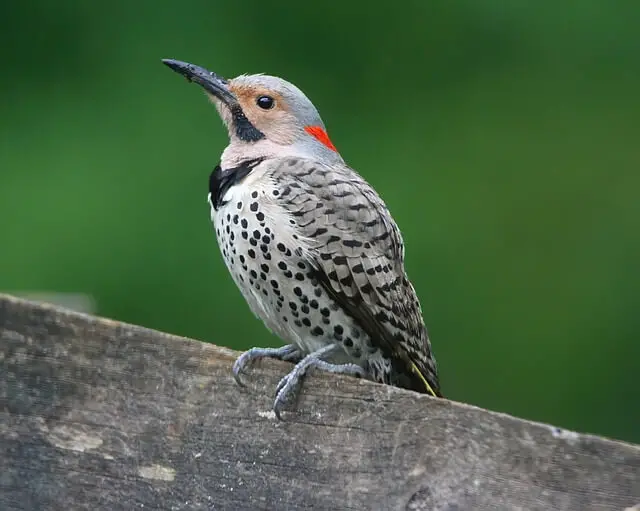
The Northern Flicker is a medium-sized bird of the woodpecker family. It is native to North America, some areas of Central America, Cuba, and the Cayman Islands, The Northern Flicker has a diverse diet with an emphasis on certain foods that are abundant in the wild.
Northern Flicker prefer the following foods: berries, fungi, aphids, snails, leeches, centipedes, slugs, snails, starfish, crayfish, crabs, shrimp, earthworms, ants, praying mantis, bees, wasps, predatory birds, and other beetles and mites. Because of their reliance on scavenging, these birds have developed highly efficient systems for storing food and for movement between food sources.
- Frequency: 20.99%
- Color: Light brown with black bars across back, chest, wings, belly
- Habitat: Forests, woodlands, backyards, edges, yards, and parks
- Range: North America, Central America, Cuba, Cayman Islands
- Size: 10 – 14″ inches
- Weight: 85 – 165 grams
- Diet: Insects (ants, beetles, invertebrates), fruits, seeds, berries
- Family: Picadae
- Genus: Colaptes
Related Post: How to Attract Northern Flickers to your yard?
The backyard birds below, have a frequency of less than 20% year-round.
- Carolina Chickadee 20.33%
- Common Grackle 18.92%
- Brown-headed Cowbird 17.15%
- Song Sparrow 16.30%
- Eastern Phoebe 16.08%
- Indigo Bunting 15.99%
- Barn Swallow 13.35%
- Northern Mockingbird 13.30%
- Ruby-throated Hummingbird 12.11%
- Chipping Sparrow 11.57%
- Blue-gray Gnatcatcher 11.46%
- Yellow-rumped Warbler 11.32%
- Eastern Wood-Pewee 11.25%
- Pileated Woodpecker 10.92%
- Eastern Meadowlark 10.78%
- Hairy Woodpecker 10.05%
- Brown Thrasher 10.03%
- Field Sparrow 9.80%
- Red-headed Woodpecker 9.42%
- Eastern Towhee 9.14%
- Eastern Kingbird 8.87%
- Common Yellowthroat 8.53%
- White-crowned Sparrow 8.45%
- Northern Parula 8.39%
- Chimney Swift 7.95%
- Belted Kingfisher 7.87%
- Red-eyed Vireo 7.85%
- Gray Catbird 7.57%
- Great Crested Flycatcher 7.29%
- Tree Swallow 7.18%
- Summer Tanager 7.04%
- Yellow-billed Cuckoo 6.82%
- Rock Pigeon 6.75%
- Cedar Waxwing 6.59%
- House Wren 6.45%
- Baltimore Oriole 6.04%
- White-eyed Vireo 5.49%
- Ruby-crowned Kinglet 5.43%
- Dickcissel 5.33%
- Eurasian Tree Sparrow 5.22%
- Northern Rough-winged Swallow 5.18%
- Warbling Vireo 5.05%
Bird Variety Across Missouri’s Seasons
Missouri’s backyard bird residents change with the seasons, offering a dynamic avian spectacle year-round. Below, we present lists highlighting the common backyard birds you can expect to see during different periods in Missouri.
These avian companions are frequently spotted in Missouri, gracing your lawn or feeders with their presence. Moreover, they prominently feature in the state’s eBird checklists, combining observations from the summer months of June and July with those from December and January in the winter.
To provide you with a concise and practical view, we’ve excluded birds that seldom make appearances in backyard settings.
This curated blend of data ensures that, regardless of the season, these are the birds you’re most likely to encounter while bird-watching from the comfort of your Missouri home.
Backyard Birds in Missouri in Summer:
- Northern Cardinal: 70.3%
- Mourning Dove: 53.9%
- American Robin: 53.1%
- Indigo Bunting: 46.6%
- Blue Jay: 46.2%
- Red-bellied Woodpecker: 41.6%
- Tufted Titmouse: 41.4%
- American Goldfinch: 39.6%
- Brown-headed Cowbird: 39.2%
- Red-winged Blackbird: 38.5%
Backyard Birds in Missouri in Winter:
- Northern Cardinal: 62.4%
- Dark-eyed Junco: 56.7%
- Blue Jay: 45.9%
- Downy Woodpecker: 45.2%
- Red-bellied Woodpecker: 43.4%
- Tufted Titmouse: 42.2%
- White-throated Sparrow: 35.9%
- American Goldfinch: 35.9%
- Mourning Dove: 34.6%
- European Starling: 34.5%
Best Bird Feeders to Attract Birds
| Bird Feeder Type | Recommended Birdseed | Attracted Birds |
|---|---|---|
| Tube Feeders | Black Oil Sunflower Seeds | Goldfinches, Chickadees, Woodpeckers, Nuthatches, Pine Siskins |
| Ground Feeders | Black Oil Sunflower Seeds | Cardinals, Jays, Finches, Sparrows |
| Platform Feeders | Millet or Corn | Sparrows, Blackbirds, Towhees, Juncos, Doves, Grackles, Starlings |
| Peanut Feeders | Peanuts | Woodpeckers, Chickadees, Nuthatches, Titmice, Jays, Juncos, Finches, Sparrows |
| Suet Feeders | Suet | Woodpeckers, Cardinals, Nuthatches, Kinglets, Wrens, Chickadees |
| Hummingbird Feeders | Hummingbird Nectar | Hummingbirds (and may attract other birds as well) |
Creating a Bird Haven in Your Missouri Yard
Elevate your birdwatching experience by enticing a diverse array of birds to your Missouri yard with these expert insights:
- Bird Feeder Diversity: Offer a variety of feeders to cater to the unique dietary preferences of different bird species.
- Water Oasis: Install a well-maintained birdbath, fountain, or flowing stream to provide a refreshing and safe water source.
- Native Flora Haven: Nurture native plants like Oaks, Beeches, Cherries, Sumacs, Hemlocks, Blackberries, Wild Grasses, Elderberries, Serviceberries, Purple Coneflowers, Sunflowers, Milkweed, Cardinal Flowers, Trumpet Honeysuckle, and Virginia Creeper. These provide both food and shelter for local birds.
- Naturalized Lawn: Allow sections of your lawn to grow longer, enabling not only cover but also natural seed sources.
- Habitat Hubs: Create brush piles to serve as multifunctional areas for foraging, protection, and nesting opportunities.
- Pesticide-Free Zone: Avoid harmful pesticides and herbicides, preserving insects and seeds for birds’ natural feeding.
- Nesting Boxes: Strategically place and maintain nesting boxes, enhancing your yard’s appeal for breeding birds.
With these strategies, transform your Missouri yard into a thriving sanctuary, fostering the well-being of both resident and migratory bird species.
Mastering Bird Identification in Missouri
Whether you’re venturing out for birding or enjoying the avian wonders from your backyard in Missouri, refining your bird identification skills is essential. Here are some insightful strategies:
- Size Matters: Size is an initial clue. Categorize birds as small (sparrow-sized), medium (pigeon-sized), or large (goose-sized) to facilitate later searches.
- Silhouettes and Shapes: Pay attention to bird silhouettes. Note tail length, bill shape, wing configuration, and overall body shape.
- Colors and Patterns: Observe head, back, belly, wing, and tail colors. Document secondary hues and intricate patterns, like bands, spots, or highlights.
- Behavior Insights: Analyze bird behavior. Are they ground-dwellers or tree-dwellers? Do they flock together, or prefer solitude? Identify their feeding habits for additional clues.
- Habitat Hints: Different bird species favor specific habitats. Note the surroundings—woodlands, parks, shrublands, grasslands, meadows, shores, or marshes.
- Digital Assistance: Utilize bird identification apps like those developed by eBird or Audubon for comprehensive guidance.
With these strategies, your journey to becoming a seasoned bird identifier in Missouri becomes an exciting and rewarding endeavor.
Missouri’s Premiere Birding Destinations
Missouri offers a plethora of exceptional spots to observe backyard birds. From the vibrant gardens of St. Louis to the serene woodlands of the Ozarks, the state is a haven for avian enthusiasts. The Missouri Botanical Garden in St. Louis boasts a diverse range of native plants, attracting numerous bird species.
For a more natural setting, the Mark Twain National Forest in the Ozarks is a hotspot, with its lush forests providing shelter and sustenance for various birds.
Additionally, the numerous lakes and wetlands, such as Loess Bluffs National Wildlife Refuge, offer ideal habitats for waterfowl and migratory birds.
To explore even more fantastic birdwatching spots, check out our comprehensive article on the subject!
FAQs: Common Backyard Birds in Missouri
What’s the most common bird in Missouri?
The most common bird in Missouri is the Northern Cardinal, with a 63.5% frequency of occurrence. The second most common bird is the Blue Jay, which has a 47.5% frequency of occurrence. The cardinal can be found throughout all parts of the state, and is even prevalent in the southernmost regions as well.
What is the rarest bird in Missouri?
The hermit warbler is the rarest bird in Missouri, with a frequency only 0.0001%. This can be attributed to its habitat, which consists of high-elevation deciduous forests and their nearby mixed hardwood forests. The species also has an extremely low reproductive rate.
Are there falcons in Missouri?
Falcons have been spotted in many places around Missouri, including St. Louis, Columbia, Jefferson City, and Joplin. There is a population of Peregrine Falcons that nest at high altitude cliffs in Perry County.
Are there purple finches in Missouri?
In the winter, Purple Finches are a common sight in Missouri. These birds can be found near woodland areas and brushy fields where they feed on insects like leafhoppers, plant lice, aphids, mites and weevils. They have been seen around St. Louis, and can be found in many other places as well. The purple finch can be attracted with sunflower seeds.
What yellow birds are in Missouri?
The most common yellow birds in Missouri are the American Goldfinches. They can be found all over the state, and they are especially common near rivers, streams, ponds, marshes, and lakes. There are also less-common yellow birds in Missouri that include the Yellow-breasted chat, Yellow-throated vireo, Nashville Warbler, and Yellow Warbler.


